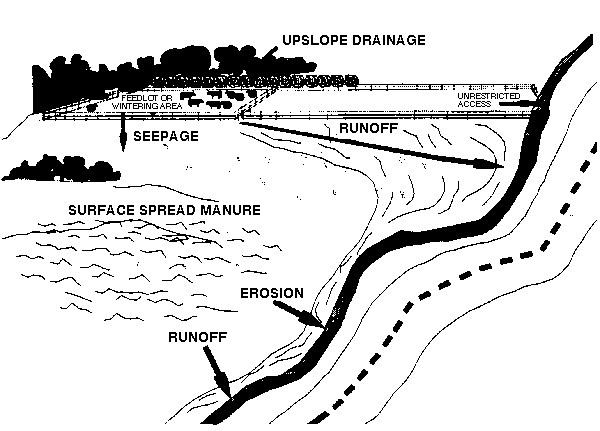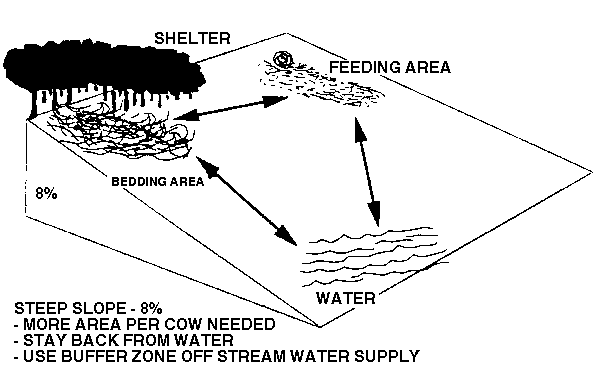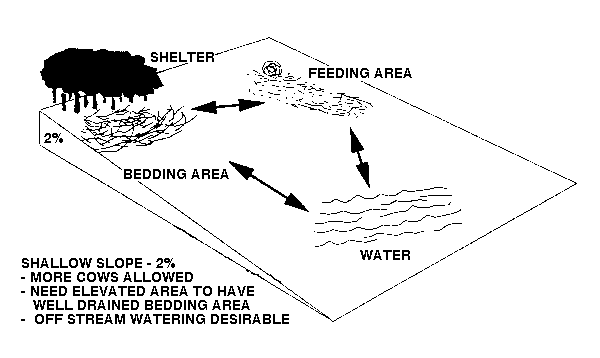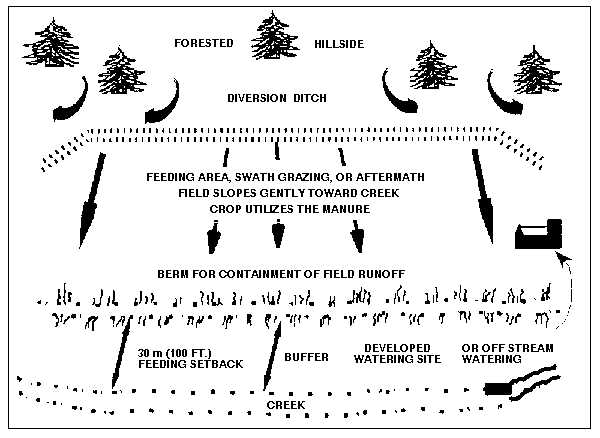| | Runoff | Seepage of manure nutrients into groundwater | Erosion | Direct access of cattle to surface water
Figure 1 shows some of the ways that pollution can occur at beef feeding sites. The major ways pollution can occur are by:
- runoff,
- seepage,
- erosion,
- direct access of livestock to water.

Figure 1. Pollution pathways from beef feeding sites
Each of these pollution possibilities are site dependent and will vary from region to region. How to minimize these possible problems is discussed below.
Runoff
An objective for all livestock operations is to provide an economical, comfortable and healthy environment for the cattle without compromising surface water quality. Several physical properties affect the degree of runoff from a beef feeding site. These include slope, soil type, amount of manure buildup and the amount of external water entering the site.
Slope
A south slope is often selected for a wintering site to gain the exposure to the winter sun. When used in combination with a natural or constructed shelter to the north, a modified environment for wintering livestock can be achieved. Such a slope, however, can pose a significant runoff problem if allowed to enter a watercourse. Choosing a sloping site with controlled runoff is therefore an important part of protecting the environment. Runoff is determined by the degree of slope, the amount of precipitation, the density of livestock on the site and the distribution of manure. Figures 2 and 3 demonstrate these principles. The slope will affect the management of the site.
Steep slope
There are several things producers can do to compensate for the slope of the feeding site. On slopes of greater than 8%, consider the following to minimize the impact of runoff on a watercourse or surface water source:
- Increase the area of the site. This decreases the density of the livestock and the concentration of manure. Figure 2 illustrates the need for increased area.
- Increase the distance from the watercourse. Locate near or at the top of the slope.
- Provide a buffer if possible between the feeding site and the watercourse. The more vegetative cover, the more effective the buffer.
- Move the feeding site frequently. This will disperse the manure and reduce the amount of contamination leaving the site. Consider alternative feeding methods such as aftermath or swath grazing.
- Use a natural wetland or treed buffer strip to utilize runoff nutrients.
- Divert off-site water around the feeding site.
- Select a site that is not subject to erosion.
- Provide off-stream water supply.
- Install a catch basin to contain runoff.
- Use minor landscaping of site to alter slope and drainage.
- Make strategic use of fences to keep cattle out of sensitive areas.

Figure 2. Runoff from a steep slope
Shallow slope
For sites with a slope less than 8% the following suggestions, in addition to those above, could be helpful. See Figure 3.
- Use a natural elevated area for the bedding area to ensure drainage.
- Use less area as greater animal density is allowable.
- Distribute the water, bedding and feeding area to utilize the entire area accessible to the cattle. This distributes the manure over the area to be utilized by the forage.
- Provide off-stream water supply if possible. If not, develop an on-stream watering site that minimizes bank disturbance. If none of the above recommendations can be done economically for a particular feeding site, consider an alternative location.

Figure 3. Runoff from a shallow slope
Windbreak fences and/or open front sheds, although expensive compared to natural shelters, can be located where they will be most effective in relation to water, feed sources and other farm buildings.
A summary of some of the management factors involved with the siting and operation of seasonal feeding sites is given in Figure 4. Keep in mind that no two sites are the same.

Figure 4. Management factors for winter feeding sites
It is impossible to give solutions that cover all siting situations.
Seepage of Manure Nutrients into Groundwater
Pollution from seepage occurs when manure nutrients are carried by soil moisture downwards through the soil profile into the groundwater. This process is difficult to assess or predict since it is not visible to the eye. The degree of a problem is largely dependent upon the permeability of the soil and the amount of manure accumulation.
Seepage potential is not as great for wintering feeding sites as it is for year-round beef feedlots. Since the soil is frozen most of the time cattle are confined, little leaching occurs. The time of possible leaching of manure nutrients into groundwater is during late spring, summer and fall. Leaching into the soil can therefore be minimized by removing the accumulated manure as soon as the cattle leave.
Points to keep in mind:
- Avoid sites on very porous soils such as sands, gravels, shale or sandstone outcroppings.
- Remove manure where it has built up over the winter season. Such locations are likely to be feed, bedding and watering areas. Removal prevents movement of nutrients into the soil when it thaws or is subject to precipitation.
- Move feeding site regularly during the winter to minimize manure buildup.
- Provide sufficient area on porous sites to reduce animal densities.
- Harrow the area in the spring to disperse the manure and straw.
- Encourage high nutrient uptake at feeding sites with appropriate vegetative cover.
Erosion
Another source of pollution from feeding sites or manure utilization areas is erosion of soil. This problem is mainly associated with manure application on lands subject to erosion to surface water. However, areas of high livestock traffic under some soil conditions will aggravate the tendency of erosion of soils into water, particularly in riparian areas and lands adjacent to water courses. Soils prone to erosion and having high nutrient content from manure application can contribute to high levels of phosphorous to surface water. This is one of the greatest causes of surface water degradation. It is important to keep in mind that, when properly managed, manure can improve the physical structure and fertility of soils, thereby decreasing the potential for erosion.
Direct Access of Cattle to Surface Water
A major source of water degradation comes from direct access of livestock to watercourses or their supply. This is a particularly serious problem in the winter when significant manure buildup occurs around the watering site in the ice. Several methods exist to supply water off stream. Many types of pumps exist, including wind powered, water powered, solar powered or cattle powered. A close look at alternative methods of water supply should be made by all producers presently using surface water for their wintering site.
Prepared by: Engineering Services
Source: Beef Herd Management Reference Binder and Study Guide 804-1 |
|